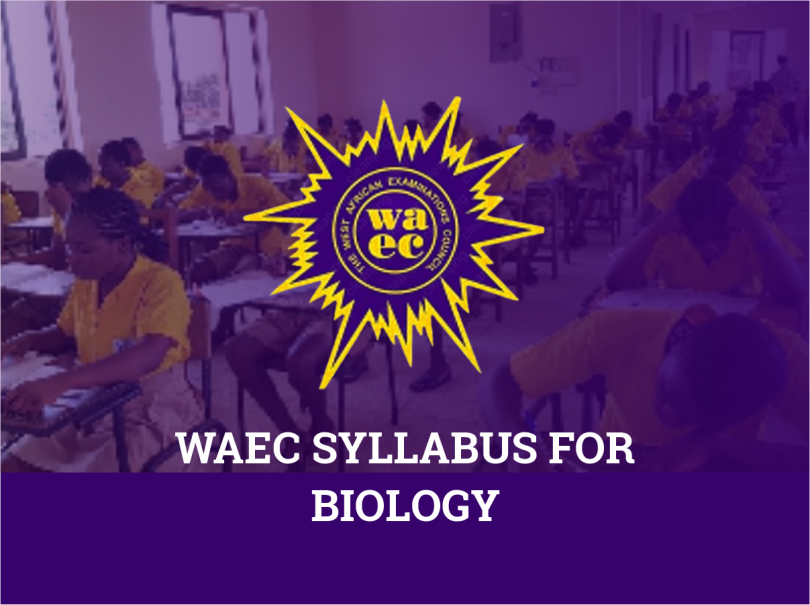The WAEC 2025 examinations are set to commence soon, and we know that every serious student is putting in the effort to prepare thoroughly. To assist with your revision, the WAEC board has released the syllabus for all subjects, including Biology. The WAEC Syllabus for Biology serves as a helpful guide for both candidates and tutors to focus their revision.
Biology is a core subject, especially for students aiming to pursue careers in the medical field, making it important to do well in the exam. Below, we have provided the full WAEC Biology syllabus along with the recommended textbooks to guide your preparation. Take the time to go through the WAEC Syllabus for Biology to ensure you are fully ready for the exam day.
Structure of the Exam
There are three papers (Paper 1, 2, and 3) that all candidates must sit for. Here’s a breakdown of each:-
Paper 1: Objective Test
- Type: 50 multiple-choice questions
- Covers: Section A of the syllabus (common to all WAEC countries)
- Marks: 50
- Duration: 50 minutes
Paper 2: Essay Test
Type: Essay + structured questions
Sections:
- Section A: Answer any 2 out of 4 essay questions (based on general content). Each is 20 marks.
- Section B: Ghana-only questions (short structured format).
- Section C: For Nigeria, Sierra Leone, The Gambia, and Liberia (short structured questions).
- Total Marks: 70
- Duration: 1 hour 40 minutes
Candidates answer 2 essay questions from Section A and all structured questions from either Section B or C, depending on their country.
Paper 3: Practical / Practical Alternative
Type: Laboratory-based questions or simulated practical test
Sections:-
- Section A: 2 compulsory questions from general biology (25 marks each)
- Section B: For Ghana only (30 marks)
- Section C: For Nigeria, Sierra Leone, Gambia, Liberia (30 marks)
- Total Marks: 80
- Duration: 2 hours
- Note: Private candidates take a test on practical work instead of real lab experiments.
WAEC Syllabus For Biology 2025
| Topic | Subtopics |
|---|---|
| Concept of Living | – Characteristics of living and non-living things |
| Classification | – Classification into Kingdoms – Differences between plants and animals |
| Organization of Life | – Levels of organization: Cell, Tissue, Organ, System – Examples: Amoeba, Euglena, Paramecium, Hydra, Bulb, Rhizome, Heart, Reproductive & Excretory Systems – Complexity of organization: advantages & disadvantages |
| Forms of Living Cells | – Single/free-living cells: Amoeba, Paramecium, Euglena – Colony: Volvox – Filament: Spirogyra – Part of the organism: Cheek cells, onion root tip, leaf epidermis |
| Cell Structure & Function | – Components of cells and their functions – Plant vs animal cells |
| Cell & Environment | – Diffusion, osmosis, active transport |
| Cell Properties & Functions | – Nutrition: autotrophic (photosynthesis), heterotrophic (holozoic) – Respiration: aerobic, anaerobic – Energy release |
| Excretion | – In single-celled organisms – Metabolic waste products |
| Growth | – Cell division, enlargement, differentiation – Dry weight, size, number of cells – Growth hormones, auxins, tropism |
| Movement | – Organelles (cilia, flagella), cyclosis |
| Reproduction | – Asexual: fission, budding, vegetative propagation – Sexual: gametogenesis, conjugation, fertilization |
| Tissues & Support | – Skeletal systems in animals: bone, cartilage, chitin – Types: endoskeleton, exoskeleton, hydrostatic – Support in plants: types and functions of tissues |
| Transport System | – Animals: heart, blood vessels, blood, lymph – Plants: water/mineral transport, translocation, transpiration |
| Respiratory System | – Gaseous exchange in fish, toads, mammals, plants |
| Excretory System | – Organs: kidney, stomata, lenticels |
| Homeostasis | – Kidney: structure & function – Liver & skin: functions |
| Hormonal Coordination | – Animal hormones: site, function, secretion issues – Plant hormones |
| Nervous Coordination | – CNS: brain parts and functions – Spinal cord, neurones, PNS, reflex arc, somatic/autonomic systems |
| Sense Organs | – Structure and function of eye and ear |
| Reproductive Systems | – Male and female structures in mammals – Gamete structure – Fertilization to birth – Birth control – Metamorphosis – Comparison in animals – Flowering plants: floral parts, gametes, fertilization |
| Pollination | – Self vs cross – Agents – Placentation types – Fruit development and types – Seed dispersal |
| Plant Nutrition | – Photosynthesis process and equation – Light/dark reactions – Conditions, materials, evidence |
| Mineral Requirements | – Macro and micro nutrients – Soil and atmospheric sources |
| Animal Nutrition | – Food classes and sources – Balanced diet – Food tests – Digestive enzymes |
| Nutrition Modes | – Autotrophic: photosynthesis – Heterotrophic: holozoic, parasitic, symbiotic, saprophytic |
| Alimentary System | – Alimentary tracts in animals – Dental formula – Feeding in protozoa and mammals |
| Ecosystem | – Components: biotic, abiotic, habitat, population, biosphere – Ecological factors: climatic, edaphic, physical |
| Trophic Levels & Energy Flow | – Food chain, web, pyramids – Energy relationships in ecosystems |
| Decomposition | – Role of decomposers – Gaseous byproducts |
| Ecological Management | – Biological associations: parasitism, symbiosis, commensalism, saprophytism |
| Adaptation | – Organisms’ adaptation to habitats |
| Pollution | – Air, water, soil pollution: sources, types, effects – Noise pollution |
| Population Ecology | – Population structure, size, growth – Succession |
Note: This is a section of the WAEC Syllabus for Biology, you can visit the WAEC website for the full syllabus.
WAEC Biology Recommended Texts
- Ndu, F.O.C., Ndu, A., & Aina, J.O. (2001). Senior secondary school biology: Books 1-3. Lagos: Longman.
- Odunfa, S.A. (2001). Essentials of biology. Ibadan: Heinemann.
- Ogunniyi, M.B., Adebisi, A.A., & Okojie, J.A. (2000). Biology for senior secondary schools: Books 1–3. Macmillan.
- Ramalingam, S.T. (2005). Modern biology, SS science series (New ed.). AFP Stan.
- Stan. (2004). Biology for senior secondary schools (Revised ed.). Ibadan: Heinemann.
- Stone, R.H., & Cozens, A.B.C. (1982). Biology for West African schools. Longman.
- Usua, E.J. (1997). Handbook of practical biology (2nd ed.). University Press Limited.
Did you find this post helpful? If so, please share it with other candidates who may benefit from this information. Feel free to drop any questions you have in the comments below, and we will respond as soon as possible.







Leave a Comment